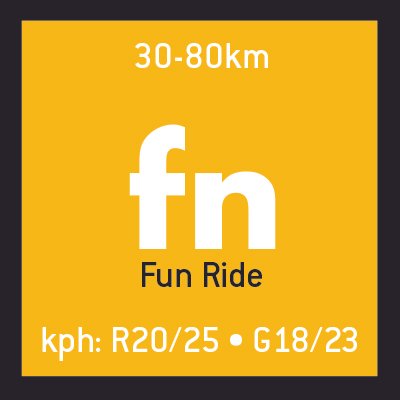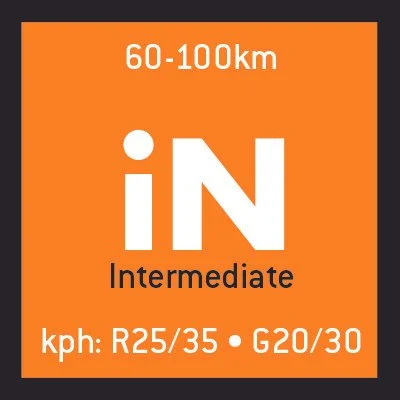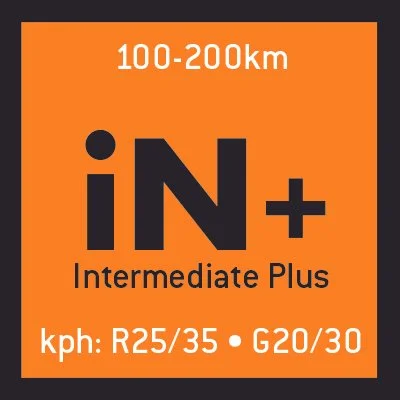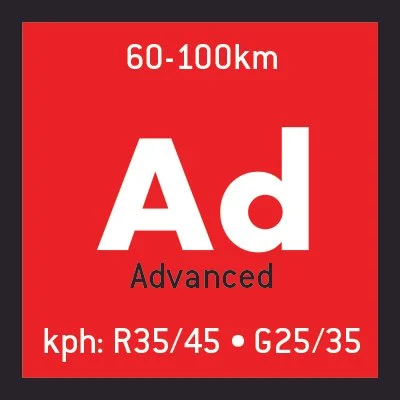LDCC Ride Levels : Something for Everyone.
LapDogs Cycling is all about riding with “like-minded” people. Volunteer run and organized, our club rides focus on riding together, having fun and connecting with new people who share our passion for cycling.
Regardless of your ability, ambition or age, you’ll find a social, fun-loving pack that suits your style with the LapDogs Cycling Club. Our ride schedules include Road, MTB, Gravel (Mixed-surface), Cyclocross, and in the cooler months we have Fatbike or track at the Milton Velodrome. In the spring, we also offer a few Ride 101 Clinics.
LDCC “Periodic Table” of Ride Levels
With a full portfolio of Ride Types and Ride Levels it can often be a bit of a challenge trying to decide what best for you. To help, we’ve categorizes our rides based on several Ride Levels which are defined by anticipate ride speed, relative effort required, rider skill level and experience, distance, and terrain). Each Ride Level will give you an indication of the following important criteria:
Distance or Ride Time
Anticipated average speed (kph) or ride type
Anticipated Skill Level or Terrain
Further below on this page we have also included fun descriptions for each Ride Level.
What Style of Bike do you need?
Simply put, we want you on the correct bike for the chosen discipline of the ride - ie: The right tool for the job at hand.
Road Rides : A Road Bike with drop handle bars and appropriate gearing is the bike of choice. In rare circumstances a “flat-bar” fitness bike may be used as long as the bike is equipped with appropriate “road-gearing” and the rider has the appropriate level of fitness to ride in a close group at the defined speed for the level of ride being presented. (Please note: The challenge with a flat-bar bike in a group is that we often ride two-abreast and the wider handle bars may be problematic and could easily become a safety issue). This is all about being efficient on the ride and having the capacity to maintain the pace of the group. In a pinch a gravel bike with slick tires will do the job… but may become a challenge on the faster rides, when speeds pick up and bigger gear ratios are required.
Gravel Rides : A Gravel or Cyclocross Bike is ideal. Given we are often on rough surfaces, doing steep climbs and yes… even wandering into the woods, you will be need a bike that is capable of a handling a variety of conditions, included pavement, gravel, dirt, sand, off-road trails, etc. Some contemporary road bikes will have the capacity to run wider treaded tire and may be suitible. A mountain bike might also be suitable on some rides, but we do find that on long gravel stretches and when speeds increase (depending on the ride), a mountain bike will be completely out-geared and not able to keep up.
MTB / Off-Road / Trail Rides : A Mountain Bike is the tool of choice. This is especially important for some of our more advanced rides in which terrain and trail conditions require a bike that has been designed to safely handle roots, rocks and other off-road obstacles. On certain rides, we do encourager drop-bar gravel and cyclocross bikes, but in these circumstances, we also plan the rides to be on appropriate terrain and trails.
Please know that this has nothing to do with making our rides non-inclusive, but has everything to do with safety on the ride and the enjoyment and satisfaction of those participating.
See the descriptions below for our various Ride Levels for Road, Gravel and Mountain Bike Group Rides. These descriptions have been written to help give you an overview and understanding of club rides so that our Members know what to expect and our RideLeads and RideHosts can plan their events accordingly.
Our LDCC Road and Gravel Rides are currently divided into SIX different levels (something for pretty much everyone).
We also offer Weekly WORKOUT (Training) Road Rides at TWO levels.
SOCIAL (Let’s go… Easy Peasy)
Road Pace : 16-20kph (when permitted by local traffic, road conditions and group dynamics)
Gravel Pace : 14-18kph (speeds are a bit slower given the nature of gravel rides and the wide variation in terrain, elevation and surfaces)
Average Distance : 20-25km
LDCC Ride Example : Road Ride 101 (Clinic)
Social Rides are intended to be inclusive, and super casual. A great ride for beginners, you should reasonably be able to hold a conversation while riding. These are no-drop rides and the group stays together. A bonus here is that Social rides typically include a coffee or bakery stop after the ride. As with any outdoors physical activity, a moderate fitness level is always recommended.
FUN (Been riding a bit, new to the Club... Start Here)
Road Pace : 20-25kph (when permitted by local traffic, road conditions and group dynamics)
Gravel Pace : 18-23kph (speeds are a bit slower given the nature of gravel rides and the wide variation in terrain, elevation and surfaces)
Average Distance : 30-80km
LDCC Ride Example : Recovery Wednesday
Fun Rides are intended to be conducted at a relaxed and moderate distance These rides are all about being social on the bike while toning up those cycling legs. As the season progresses the length may be extended up to 80 km (e.g. Oakville and back). You should reasonably be able to hold a conversation while riding. These are no-drop rides and the group is expected to stay together. A bonus here is that just like the Social Rides, Fun Rides typically include a coffee or bakery stop at the half-way mark. As with any outdoors physical activity, a moderate fitness level is recommended.
WORKOUT RIDE (Ready to Take it Up a Notch)
Road Pace : 20-30kph (when permitted by local traffic, road conditions and group dynamics)
Average Distance : 30-40km
LDCC Ride Example : Friday Hillervals
Workout Rides are to be considered Training Road Rides and they make up a large portion of our weekday morning and evening rides. The goal of this type of ride is to challenge yourself at hill climbing or doing loops at a higher pace, or sometimes both! These are no-drop rides, though the group may separate occasionally and regroup at the top of a hill, after a loop. There is often a mix of advanced riders looking to take it easier for a day, and also recreational riders looking for a harder workout. These rides are, by necessity, pretty fluid in terms of adjusting to the various expectations and abilities of the people who turn out on any given day. Group ride experience and moderate fitness level is highly recommended.
WORKOUT RIDE “PLUS” (Things may get Spicy)
Road Pace : 30-40kph (when permitted by local traffic, road conditions and group dynamics)
Average Distance : 30-40km
LDCC Ride Example : Sleepy Puppy / Skinny Puppy
Workout Ride “Plus” are the next level of Training Road Rides and are generally integrated into our weekday morning and evening rides. Like any workout, the goal of this ride is to challenge yourself. These are no-drop rides, though the group may separate occasionally and regroup at the top of a hill, after a loop. These rides are, by necessity, pretty fluid in terms of adjusting to the various expectations and abilities of the people who turn out on any given day. Solid group ride experience and a high fitness level is required.
INTERMEDIATE (Time to begin pushing the Distance)
Road Pace : 25-35kph (when permitted by local traffic, road conditions and group dynamics)
Gravel Pace : 20-30kph (speeds are a bit slower given the nature of gravel rides and the wide variation in terrain, elevation and surfaces)
Average Distance : 60-100km
LDCC Ride Example : Klienburg Loop
Intermediate rides take place on weekends. The goal of this ride is to build up your stamina by increasing mileage and exploring longer routes outside the city limits. These are no-drop rides, but to go the distance you’ll need to be okay with spending a few hours in the saddle. Be prepared with extra hydration and stock proper ride fuel in that jersey pouch. The pack will either re-group or split up if some riders are lagging. You should be comfortable riding in a pace line, know when it’s your turn to take the lead and when you should tuck in to draft off a wheel. Group ride experience and a moderate to high fitness level is highly recommended (especially on our longer rides, where elevation adds to the overall effort).
INTERMEDIATE “PLUS” (On for the Long-haul)
Road Pace : 25-35kph (when permitted by local traffic, road conditions and group dynamics)
Gravel Pace : 20-30kph (speeds are a bit slower given the nature of gravel rides and the wide variation in terrain, elevation and surfaces)
Average Distance : 100-200km +
LDCC Ride Example : Honey Pup / Niagara Ride
Intermediate “Plus” rides take place on weekends. These rides are going to push your Endurance. These are no-drop rides, but to go the distance you’ll need to be okay with spending a a good part of the day in the saddle. Be prepared with extra hydration and stock proper ride fuel in that jersey pouch. The pack will either re-group or split up if some riders are lagging. You should be comfortable riding in a pace line, know when it’s your turn to take the lead and when you should tuck in to draft off a wheel. Group ride experience and a moderate to high fitness level is highly recommended (especially on our longer rides, where elevation adds to the overall effort).
ADVANCED (Feel the Need for Speed)
Road Pace : 35-45kph (when permitted by local traffic, road conditions and group dynamics)
Gravel Pace : 25-35kph (speeds are a bit slower given the nature of gravel rides and the wide variation in terrain, elevation and surfaces)
Average Distance : 60-100km
LDCC Ride Example : Sunday Streetsville Loop
Advanced Rides require a high level of fitness and experience. Distances may sometimes be shorter, but you can expect the pace to be higher in that case. We don’t like to leave people behind, but… these maybe considered to be DROP Rides. Solid group ride experience and bike handling skill is an absolute must. If you get dropped, the group might not wait you and you're on your own. Highly seasoned riders and experiences club veterans very often participate in these rides. Please note that speeds are high, competitive pace lines are a part of the game as well as obeying the rules of the road. A high fitness level and rider skill-level is highly recommended.
Advanced Gravel Rides also tend to explore off-road trails, un-assumed roads, climbs with technical descents and difficult mixed-surface terrain - appropriate bike handling skills and experience is required.
ADVANCED “PLUS” (Going Fast…. Going Long)
Road Pace : 35-45kph (when permitted by local traffic, road conditions and group dynamics)
Gravel Pace : 25-35kph (speeds are a bit slower given the nature of gravel rides and the wide variation in terrain, elevation and surfaces)
Average Distance : 100-200km +
LDCC Ride Example : Gravelishious
Advanced “Plus” Rides require a high level of fitness and experience. Distance is usually in excess of 100km, and you can expect the pace will be quick. We don’t like to leave people behind, but… these maybe considered to be DROP Rides. Solid group ride experience and bike handling skill is an absolute must. If you get dropped, the group might not wait for you and you're on your own. Highly seasoned riders and experiences club veterans very often participate in these rides. Please note that speeds are high, competitive pace lines are a part of the game as well as obeying the rules of the road. A high fitness level and rider skill-level is highly recommended.
Advanced “Plus” Gravel Rides also tend to explore off-road trails, un-assumed roads, climbs with technical descents and difficult mixed-surface terrain - appropriate bike handling skills and experience is required.
When it comes to LDCC Mountain Bike Rides… things are a little different…
Mountain bike rides are unique. You are riding in the woods, sometimes in remote locations, where it is hard to call for help if a rider gets into difficulty. A mechanical, crash or bonk can affect the ride for everyone involved, so participants in club MTB rides are asked to minimize the risk of any of these things happening. To this end, the following requirements apply to all club MTB rides, regardless of level:
You need a mountain bike in good mechanical shape. Hybrids, gravel bikes and cyclocross bikes are not permitted on club mountain bike rides, unless specifically stated in the club’s ride description;
Every participant must bring on the ride, at a minimum, a spare innertube, inflation (pump or CO2), tire levers and a multitool. A quick link for your chain is also a good idea. Even if you do not know how to use all of these things, bring them anyway, as someone else on the ride will;
Every participant must bring enough water/hydration and food/fuel to get through the ride. Bonking in the middle of the woods is not fun;
Know your limits: if you are getting tired, are finding a trail too technical or difficult, or are simply not having a good day on the bike, let the ride host know and the ride will either be adjusted, or steps will be taken to get you back to the trailhead;
A working knowledge of Trailforks is an asset, and has become the norm for LapDogs organized MTB group rides. Although not mandatory, learning how to navigate in the wilderness is a really powerful skill to have, and it’s a great suggestion for anyone looking to embark on a group or solo MTB ride on trails;
The emphasis is on fun and inclusivity, and creating an atmosphere that is fun and supportive. If a rider doesn’t feel comfortable riding a technical trail feature, tricky climb or fast downhill, that is fine. They should not, under any circumstances, be subjected to any pressure to ride anything outside of their comfort zone;
Obey all local trail signage and directions at all times;
Above all else, ride with respect at all times.
Remember that for the most part we are riding on natural trails, in a natural setting so you must:
Stay on trails, don’t make new lines, jumps or build new trails without permission.
Leave no trace, pack and take away your garbage, if taking photos –do so safely.
Do not ride on trails after rain or when muddy. Tire erosion can be devastating to the natural surface, let’s care of our trails so we can enjoy them for years to come;
Respect other trail users always yield to foot traffic and other users such as horses.
Downhill riders always yield to uphill riders.
Let other users know the size of the group and use a bell when it is necessary.
Let’s all be friendly out there, say hello to fellow riders.
The LDCC Ride Host / Lead is empowered to prevent anyone who does not comply with these general guidelines from participating in the ride, for everyone’s safety. We want everyone to be safe, happy and to feel welcome on the ride. Keep in mind that the more advanced the ride, the more strong riders are likely to come out, and the faster the pace may become.
LDCC TRAIL RATING
LDCC MTB rides are rated in both technical and physical (fitness challenge) difficulty. The rating system for technical trail riding is based on the IMBA Technical Trail Rating System, whereas the fitness challenge is based on factors such as climbs, distance and pace. Here are the different categories used by LDCC for this rating.
Technical Trail Difficultly Rating System: Please see the attached chart below from IMBA (International Mountain Bike Association) which defines difficulty based on trail terrain and features. LapDogs hosted rides in Ontario will almost always be Green-Blue-Single Black Diamond and will be defined on a case by case basis. The rating will be put into the description of the specific ride. Almost all the trail systems ridden on LDCC MTB rides are on Trailforks which is a good guide also using the IMBA.
Physical Trail Difficulty: This rating is subjective but here are some basic guidelines for rating the physical (fitness) aspect of a mountain bike ride:
FUN (Let’s get the Party Started)
MTB Fun Rides will be short, 1-2 hours of riding at a reasonable pace that the entire group is capable of keeping up with. The group will typically stop at all intersections prior to moving on to the next section. These trails will likely have less climbing, and be on hard packed surfaces, and are therefore the least challenging to ride from a fitness standpoint. Typically these rides would be on less technically challenging terrain but could be on more technical trails. An example would be a session ride, with less climbing and speed, but technically more difficult terrain to focus on skill building.
SERIOUS (Okay… Things are Getting Interesting)
MTB Serious Rides are typically 1.5-3 hours in length, but can also be at a faster pace, have longer/steeper climbs, or more loose surfaces making the rides more challenging than a FUN ride from a fitness standpoint. The group will typically stop at all intersections prior to moving on to the next section, or use a spotter at intersections to ensure no riders miss a turn and get lost. These rides would be on a variety of types of Technical Terrains Green-Black Diamond.
EPIC (This One Goes to Eleven!)
MTB Epic Rides are typically 2-3++ hours in length and may also be at a faster pace, have longer/steeper climbs, or more loose surfaces or rougher terrain making the rides more challenging than a SERIOUS ride from a fitness standpoint. The group will use a spotter at intersections to ensure no riders miss a turn and ensuring that the ride remains as continuous as possible, but will stop periodically to ensure the correct ride order has been defined to maximize rider enjoyment. These rides would be on a variety of trail terrains, however expect the rides to be longer, faster, and on more difficult terrain.














